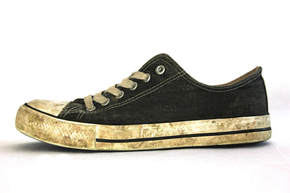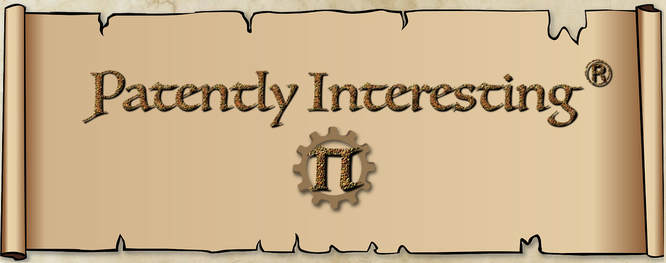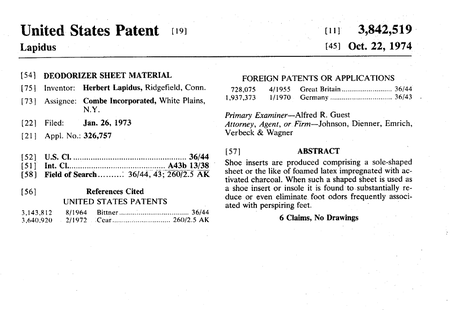
On October 22, 1974, U.S. Patent No.: 3,842,519 issued to Dr. Herbert Lapidus for "Deodorizer Sheet Material". Although generically titled as a "material", the '519 patent was directed to a shoe insert that was commercially sold as the Odor-Eaters® shoe insole by Combe Inc., starting in 1974.
The inspiration for the Odor-Eaters® product was Elizabeth Combe, the wife of Ivan DeBlois Combe, who was the founder of Combe Inc. While on a trip to England, Mrs. Combe noticed a product called "Fresh Sox", which was a shoe insole comprised of activated charcoal enclosed in paper. Dr. Lapidus was intrigued with the product when Mrs. Combe showed it to him, but he quickly grasped its deficiencies. In particular, he knew the paper would quickly decompose and make a mess in shoes. Dr. Lapidus decided to develop a more practical product.
After some experimentation, Dr. Lapidus developed a shoe insole comprised of a layer of fabric on top of which was deposited a layer of latex foam containing finely divided activated charcoal. The latex foam was formed from an aqueous slurry of styrene-butadiene to which the charcoal, an accelerator and other components were added and mixed together. During mixing, air was injected to produce the foam.
Someone else within Combe came up with the idea of producing a single (large) size of insole and then printing a shoe size template on its bottom side to permit the insole to be trimmed to a desired shoe size.
The inspiration for the Odor-Eaters® product was Elizabeth Combe, the wife of Ivan DeBlois Combe, who was the founder of Combe Inc. While on a trip to England, Mrs. Combe noticed a product called "Fresh Sox", which was a shoe insole comprised of activated charcoal enclosed in paper. Dr. Lapidus was intrigued with the product when Mrs. Combe showed it to him, but he quickly grasped its deficiencies. In particular, he knew the paper would quickly decompose and make a mess in shoes. Dr. Lapidus decided to develop a more practical product.
After some experimentation, Dr. Lapidus developed a shoe insole comprised of a layer of fabric on top of which was deposited a layer of latex foam containing finely divided activated charcoal. The latex foam was formed from an aqueous slurry of styrene-butadiene to which the charcoal, an accelerator and other components were added and mixed together. During mixing, air was injected to produce the foam.
Someone else within Combe came up with the idea of producing a single (large) size of insole and then printing a shoe size template on its bottom side to permit the insole to be trimmed to a desired shoe size.


